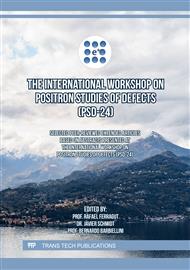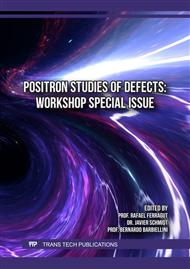[1]
A. I. Hawari, "North Carolina State University PULSTAR Reactor," Encyclopedia of Nuclear Energy, Elsevier, Netherlands, (2021)
DOI: 10.1016/b978-0-12-819725-7.00048-9
Google Scholar
[2]
A. I. Hawari, D. W. Gidley, J. Moxom, A. G. Hathaway, and S. Mukherjee, Operation and testing of the PULSTAR reactor intense slow positron beam and PALS spectrometers, Journal of Physics: Conference Series, 262 (2011) 012024
DOI: 10.1088/1742-6596/262/1/012024
Google Scholar
[3]
C. Hugenschmidt, C. Piochacz, M. Reiner and K. Schreckenbach, The NEPOMUC upgrade and advanced positron beam experiments, New Journal of Physics, 14 (2012) 055027
DOI: 10.1088/1367-2630/14/5/055027
Google Scholar
[4]
A. van Veen, H. Schut, F. Labohm, J. de Roode, Positron extraction and transport in a nuclear-reactor-based positron beam, Nucl. Instrum. Methods Phys. Res. Sect. A 427 (1999) 266
DOI: 10.1016/s0168-9002(98)01517-4
Google Scholar
[5]
K. Sato, Q. Xu, T. Yoshiie, T. Sano, H. Kawabe, Y. Nagai, K. Nagumo, K. Inoue, T. Toyama, N. Oshima, A. Kinomura, Y. Shirai, Development of a mono-energetic positron beam line at the Kyoto University Research Reactor, Nucl. Instrum. Methods Phys. Res. B 342 (2015) 104-107
DOI: 10.1016/j.nimb.2014.09.022
Google Scholar
[6]
M. Liu, J. Moxom, A. I. Hawari, and D. W. Gidley, The Intense Slow Positron Beam Facility at the PULSTAR Reactor and Applications on Nano-materials Study, AIP Conf. Proc., 1525 (2013) 455-459
DOI: 10.1063/1.4802370
Google Scholar
[7]
M. Liu, A. I. Hawari, The upgraded intense positron beam facility at the PULSTAR reactor, AIP Conf. Proc. 2182 (2019) 040008
DOI: 10.1063/1.5135840
Google Scholar
[8]
D.W. Gidley, H-G Peng, R. S. Vallery, "Positron Annihilation as A Method to Characterize Porous Materials", Annual Review of Materials Research, 36 (2006) 49–79
DOI: 10.1146/annurev.matsci.36.111904.135144
Google Scholar
[9]
M. Charlton & J. Humberston, Positron physics. (Cambridge University Press: 2001).
Google Scholar
[10]
M. Puska & R. Nieminen, Theory of positrons in solids and on solid surfaces, Reviews of modern Physics 66 (1994) 841
DOI: 10.1103/revmodphys.66.841
Google Scholar
[11]
P. Schultz, & K. Lynn, Interaction of positron beams with surfaces, thin films, and interfaces, Reviews of Modern Physics 60, (1988) 701
DOI: 10.1103/revmodphys.60.701
Google Scholar
[12]
Coleman, P. Positron beams and their applications. (World Scientific, 2000)
Google Scholar
[13]
Y. Jean, P. Mallon, & D. Schrader, Principles and applications of positron & positronium chemistry. (World Scientific: 2003)
DOI: 10.1142/9789812775610_0001
Google Scholar
[14]
J. J. Wall, C. M. Parish, J. T. Dixon, A. I. Hawari, M. Liu, and L. Breon, Irradiation of ultrasonic sensors and adhesive couplants for application in light water reactor primary loop piping and components, Nuclear Engineering and Design 414 (2023) 112594
DOI: 10.1016/j.nucengdes.2023.112594
Google Scholar
[15]
L. R. Gomez-Hurtado, R. McRobie, C. H. Shiau, Y. Q. Wu, M. Liu, C. Fleming, A. I. Hawari, C. Sun, and G. Yang, Microstructure and Defect Study of Wide Bandgap β-Gallium Oxide, Transactions of the American Nuclear Society, 128 (2023) 222-224
Google Scholar
[16]
L.R. Gomez-Hurtado, R. McRobie, M. Liu, C. Fleming, A. I. Hawari, and G. Yang, Investigation of the Evolution of Defects in Wide Bandgap β-Gallium Oxide, Transactions of the American Nuclear Society, 129 (2023) 398-400
Google Scholar
[17]
Y. Wu, G. Yang, D. Han, M. Liu, A. I. Hawari, M. Du, J. Peng, C. Foster, S. Chen, M. Koschan, and C. L. Melcher, Role of Lithium Codoping in Enhancing the Scintillation Yield of Aluminate Garnets, Phys. Rev. Applied 13, (2020) 064060
DOI: 10.1103/physrevapplied.13.064060
Google Scholar
[18]
C. M. Burba, K. Feightner, M. Liu, A. I. Hawari, The Effect of Fluorinated Solvents on the Physicochemical Properties, Ionic Association, and Free Volume of a Prototypical Solvate Ionic Liquid, Chem. Phys. Chem. 23 (2022) e202100548
DOI: 10.1002/cphc.202100548
Google Scholar
[19]
J. Ø. Torstensen, M. Liu, S. Jin, L. Deng, A. I. Hawari, K. Syverud, R. J. Spontak, and Ø. W. Gregersen, Swelling and free-volume characteristics of TEMPO-oxidized cellulose nanofibril films, Biomacromolecules, 19 (2018) 1016-1025
DOI: 10.1021/acs.biomac.7b01814
Google Scholar
[20]
S. Nandi, et al., A single-ligand ultra-microporous MOF for precombustion CO2 capture and hydrogen purification, Science advances, 1 (2015) 1-9
Google Scholar



